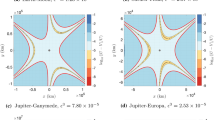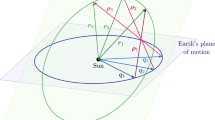Abstract
An ephemeris has been obtained for Explorer 28 (IMP 3) which agrees well with 2 years of radio observations and with SAO observations a year later. This ephemeris is generated over the 3 year lifetime by a numerical integration method utilizing a set of initial conditions, at launch and without requiring further differential correction. Because highly eccentric orbits are difficult to compute with acceptable accuracy and because a long continuous arc has been obtained which compares with actual data to a known precision, this ephemeris may be used as a standard for computing highly eccentric orbits in the Earth-Moon system.
Orbit improvement was used to obtain the initial conditions which generated the ephemeris. This improvement was based on correcting the energy by adjusting the semimajor axis to match computed times of perigee passage with the observed. This procedure may generate errors in semimajor axis to compensate for model errors in the energy; however this compensation error is also implicit in orbit determination itself.
Similar content being viewed by others
References
Brouwer and Clemence:Methods of Celestial Mechanics, Academic Press, New York, p. 529.
Cook and Scott: 1967,Planetary Space Sci. 15, 1549–56.
King-Hele, D. G.: personal communication.
Kozai: 1962,Astron. J. 67, 591–8.
Lidov, M. L.:Planetary Space Sci. 9, 719–59 (Transl. Iskusstvennye Sputniki Zemli 8, 1961).
Musen, P.: 1963, ‘A Discussion of Halphen's Method for Secular Perturbations and its Applications to the Determination of Long Range Effects in the Motion of Celestial Bodies, Part I’, NASA R-176.
National Space Science Data Center: “Data Catalogue of Satellite and Rocket Experiments” NSSDC 68-01, GSFC.
Paddack, S. J. and Shute, B. E.: 1965, ‘IMP-C Orbit and Launch Time Analysis’, GSFC X-643-65-40.
Renard, M. L.: 1968, ‘Approximate Stability Criteria for Highly Eccentric Orbits about the Earth’, IAF paper AD83 (preprint), 19th International Astronautical Congress, New York.
Renard, M. L.: 1969, ‘Practical Stability of Highly Eccentric Orbits Quasi-Normal to the Ecliptic’, Preprint, No. 69-926, AIAA/AAS Astrodynamics Conference.
Shute, B. E.: 1964, ‘Prelaunch Analysis of High Eccentricity Orbits’, NASA Tech. Note D-2350.
Smith, Jr. A. J.: 1964, ‘A Discussion of Halphen's Method for Secular Perturbations and its Applications to the Determination of Long Range Effects in the Motions of Celestial Bodies, Part II’, NASA R-194.
Whitlock, F., Wolf, H., Lefton, L., and Levine, N.: 1967, ‘ITEM Program Manual Fortran IV Version’, GSFC X-643-67-364.
Author information
Authors and Affiliations
Rights and permissions
About this article
Cite this article
Lowrey, B.E. Ephemeris of a highly eccentric orbit: Explorer 28. Celestial Mechanics 5, 107–125 (1972). https://doi.org/10.1007/BF01229516
Received:
Issue Date:
DOI: https://doi.org/10.1007/BF01229516




